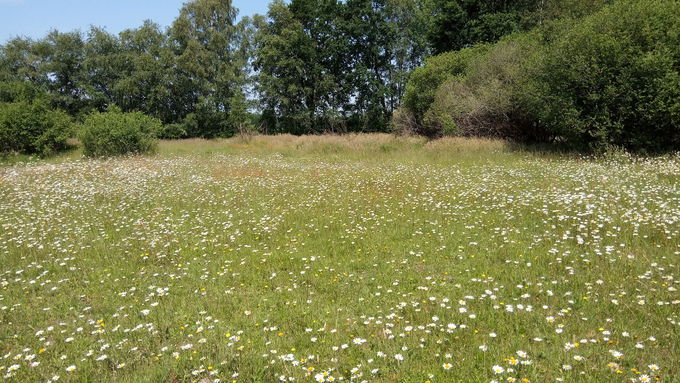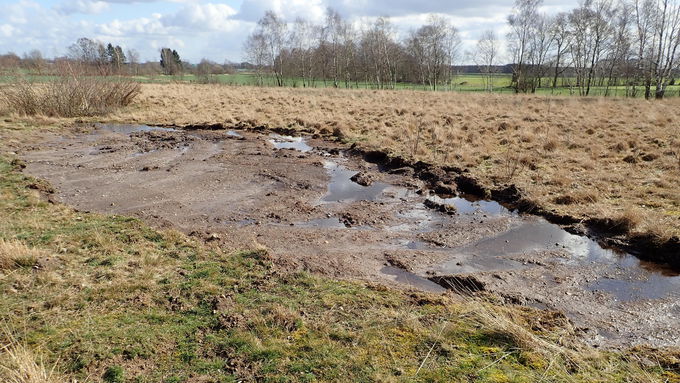A sea of blossom: the Nardus grassland near Badenstedt in June © Sarina Pils, ÖNSOR
main content
Project of the month
#12/2020 OPTIMIZATION FOR THE "PLANT SOCIETY OF THE YEAR 2020”
Nardus grasslands near Badenstedt – a nature reserve in a long sleep
In co-operation with the ‘Ökologische NABU-Station Oste-Region’ (ÖNSOR), the Department for Nature Conservation and Landscape Management of the District of Rotenburg (Wümme) and the City of Zeven, the Lower Saxony Water Management, Coastal Defence and Nature Conservation Agency (NLWKN) implemented extensive measures to preserve the valuable nature reserve ‘Borstgrasrasen bei Badenstedt’ (Nardus grasslands near Badenstedt). The measures took place in the framework of the LIFE integrated project ‘Atlantic Region DE’.
Nardus grasslands were once created by extensive grassland use, especially grazing. However, abandonment and intensification of use led to the decline of these species-rich habitats, so that today they are among the most endangered habitat types in Lower Saxony.
The approximately seven hectare large nature reserve ‘Borstgrasrasen bei Badenstedt’ is home to one of the largest and best preserved stocks of Nardus grasslands in the district of Rotenburg (Wümme). Beside the name-giving matgrass (Nardus stricta), rare plant species like flea sedge (Carex pulicaris), ordinary devil’s bit (Succisa pratensis), bog asphodel (Narthecium ossifragum), marsh gentian (Gentiana pneumonanthe) and heath spotted-orchid (Dactylorhiza maculata) occur in this area. But also numerous species of wild bees, butterflies and other insects as well as reptiles and amphibians find a valuable habitat there. Lack of grazing pressure with accompanying scrub encroachment, however, increasingly led to the displacement of the competition-weak plant species. Measures to protect and develop this habitat thus had to be taken urgently.
Therefore, in February 2020, extensive wood clearing, especially of pioneer wood such as birches, poplars and willow bushes, was carried out to increase the area of Nardus grasslands and counteract succession. At the same time, this measure served to connect an isolated Nardus grassland area with the main area. Nevertheless, young willows and blackberry bushes were removed with an excavator, so that the plant species worthy of protection and weak in competition may better establish against the dominant species. Open soil areas were created to promote the existing seed potential. Existing former marl pits in the area were cleared, desludged and redesigned in a near-natural way in order to optimize the habitat conditions for amphibians, such as the palmate newt (Lissotriton helveticus).
In order to counteract the emergence of woody plants, blackberries and purple moor grass effectively and in the long term, an initial grazing of about 600 sheep and goats was carried out in 2019 by Hehmsoth sheepherding. The grazing was repeated in two grazing rounds of about two weeks each in 2020 and is already planned for 2021.
The implementation of this action has been supervised on site by the ‘Ökologische NABU-Station Oste-Region’ (ÖNSOR). This includes not only the supervision of the use of machines and of the grazing, but also a survey of the plant species populations, an inventory of butterflies as well as a monitoring.
Thanks to the cooperation of NLWKN, the Department for Nature Conservation and Landscape Management, ÖNSOR and the City of Zeven as landowner within the framework of the LIFE integrated project ‘Atlantic Region DE’, an essential contribution could be made towards the preservation of this valuable habitat type in the district of Rotenburg. In the third project phase of the LIFE IP, further similar actions are to be implemented in Lower Saxony.
By the way: The Nardus grasslands have been declared ‘Plant Society of the Year 2020’ in Germany.
Related topics
Further links
- Ökologischen NABU-Station Oste-Region (ÖNSOR) (in German) (external link opens in a new window)
- Naturschutzgebiet „Borstgrasrasen bei Badenstedt“ (in German) (external link opens in a new window)
- LRT 6230* - Artenreiche Borstgrasrasen – Bundesamt für Naturschutz (external link opens in a new window)
- Plant Society of the Year 2020 – Floristisch-soziologische Arbeitsgemeinschaft e.V. (in German) (external link opens in a new window)





